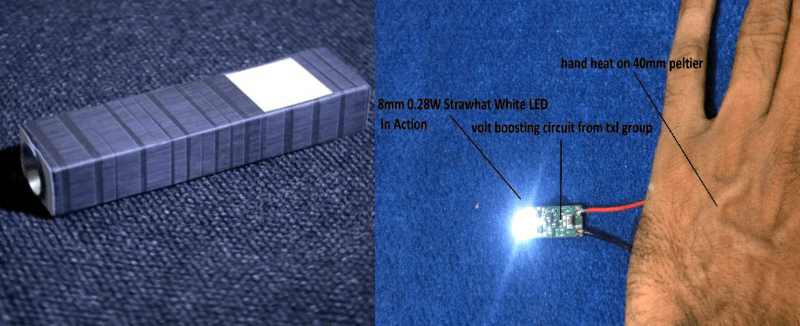We are smack-dab in the middle of our Energy Harvesting Challenge, and [wasimashu] might have this one in the palm of his hand. Imagine a compact flashlight that doesn’t need batteries or bulbs. You’d buy a 10-pack and stash them everywhere, right? If there’s nothing that will leak or break or expire in your lifetime, why not have a bunch of them around?
Infinity uses nothing but body heat to power a single white LED. It only needs a five-degree temperature difference between the air and your hand to work, so it should be good in pretty much any environment. While it certainly won’t be the brightest light in your collection, it’s a whole lot better than darkness. Someday, it might be the only light around that works.
As you might expect, there’s a Peltier unit involved. Two of them, actually. Both are embedded flush on opposite sides of the hollow aluminum flashlight body, which acts as a heat sink and allows air to pass through. After trying to boost the output voltage with a homemade feedback oscillator and hand-wound transformers, [wasimashu] settled on a unipolar boost converter to reach the 5V needed to power the LED.
[wasimashu] has made it his personal mission to help humanity through science. We’d say that Infinity puts him well on the way, and can’t wait to see what he does next.



















Celcius.
Ok. 80% more in ‘merika. The other 95% of the planet will happily understand it to be what it says. Dunno why the dude uses footcandles though. How quaint.
Most of this week has been more than 30C here, and hand temperature (just measured it) is 31C. In an air conditioned environment (26C) my hand is less than 30C. So, sadly, it won’t work here. Neat idea, but I wonder if it would ever work when I need it.
Clearly you should reverse the polarity of the tec and use your hand to cool the unit. If you warm the whole unit up to 85C in the sun and then grab onto it should provide way more power than the current implementation. Of course solar + battery would be more efficient, but…
Just what you need. A torch in sunlight ;)
This is what I’m afraid of as well. I tried making one of these before and it barely worked when I wanted to. But hey, there’s always that “better than nothing”. It would probably work if you rub your hands together to create enough heat (and would probably give you light a few seconds at a time.)
Fill it with salt water and put it in the freezer.
Somebody already invented this…
https://www.youtube.com/watch?v=tUKqRttb3Ag
Dang! I *knew* I’d seen it before. I should have twigged earlier — I used to work with her father.
So now I’ve learned about an old British colloquialism, “twigged”.
Yep, and she is not the first one to think about it. TEG was used for a long time.
But for all practical purposes, the flashlights with crank dynamos are way better: they produce more light, they can be turned for a little while and then provide light for a while longer without the human. Plus, they come in all shapes and sizes.
She clearly didn’t invent this.
Flashlights with thermoelectric generators were already available much earlier. I remember seeing one from a German manufacturer of TEGs. You could buy it, but it was merely meant as a demonstration of their TEGs, and they discontinued it long ago, because it wasn’t really of much use. They also sold TEGs that you could bury in your garden, where they would use the temperature difference between soil and air.
A damp spong cut to fit inside, interference fit, but with 1/4 of the space on each side if the sponge, evap cooling the inside. Hand is still usual temp. If not, blow on it as you might with any fire-stick. And some do not know lux or lumen but most know fc…
In the flashlight community, we usually laugh at anyone using foot-candles or candlepower, because these things are measured in lumens, candelas, lux, and meters. Lumens are the sum of all light output in all directions, while candelas are the intensity of the hotspot at a standardized distance of 1 meter. Lux indicates the intensity at any arbitrary point, the brightness of a surface.
Like, a light which makes 800 lumens can illuminate a room about as well as a common light bulb. And if it makes 10,000 candelas, it has an ANSI-standard throw of 200 meters, meaning that 200 meters away it’ll illuminate objects to 0.25 lux, about the same as moonlight.
If I go to Google and search for “foot-candle”, it pops up a definition:
“a unit of illumination (now little used) equal to that given by a source of one candela at a distance of one foot (equivalent to one lumen per square foot or 10.764 lux).”
Normally 1 lumen spread over 1 meter is 1 lux, but thanks to the inverse square law and a ratio of 3.28 feet per meter, that makes one lumen at one foot 3.28**2 lux, or 10.764. This is needlessly complicated, hence why the unit isn’t often used.
Can you suggest some solution for measuring lumens that is not super expensive? You can buy flashlights from eBay that claim to have something like 10000+ lumens, and when you measure their power they’re like 10W, which makes them 1000 lumens at best. But directly measuring lumens would be much better.
More to do with BS advertising and too cheap to be true.
Actually, it looks like the manufacturer of the part he mentions invented this. http://www.txlgroup.com/voltage_converters.html and https://youtu.be/IvMeGX0aI08 of note.
“High-power thermoelectric generator utilizes thermal difference of only 5°c”
http://www.newelectronics.co.uk/electronics-news/high-power-thermoelectric-generator-utilises-thermal-difference-of-only-5c/175937/